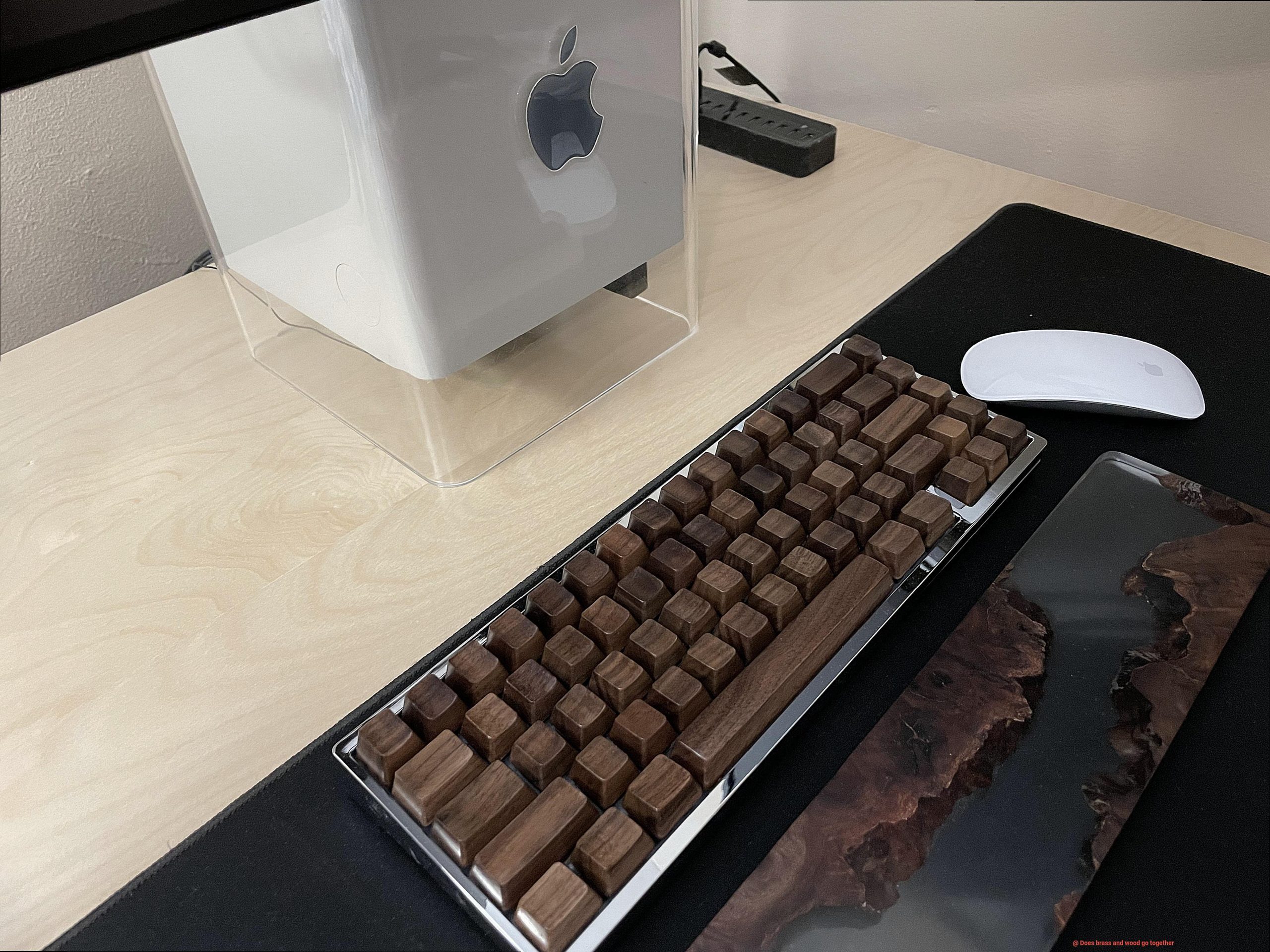Today, we’re diving into the captivating question that has designers, decorators, and home enthusiasts buzzing: do brass and wood make a winning combination? The mingling of warm, earthy wood tones with the timeless allure of brass has long been a topic of fascination.
While some may argue that these materials clash, we firmly believe there’s an undeniable charm when brass and wood join forces in perfect harmony. In this post, we’ll explore why this combo works so well, showcase stunning examples of its success, and dish out practical tips for incorporating brass and wood into your own space.
So get ready to uncover a truly mesmerizing pairing that effortlessly blends classic and contemporary aesthetics, creating an atmosphere that’s both visually striking and exquisitely refined.
Visual Appeal of Combining Brass and Wood
Contents
- 1 Visual Appeal of Combining Brass and Wood
- 2 Decorative Uses for Brass and Wood
- 3 Functional Uses for Brass and Wood
- 4 Design Considerations for Combining Brass and Wood
- 5 Adhesive Options for Bonding Brass and Wood
- 6 Mechanical Fasteners for Securing Brass and Wood
- 7 Maintenance Tips for Preserving the Beauty of Brass and Wood
- 8 Cleaning Techniques for Keeping Brass and Wood Looking Great
- 9 Conclusion
In the world of interior design, the perfect combination of materials can transform a space into something truly remarkable. One pairing that has stood the test of time is the fusion of brass and wood. The visual appeal of this combination lies in the distinct characteristics of each material and the harmonious balance they create.
Brass, a metal alloy composed primarily of copper and zinc, exudes elegance and sophistication with its lustrous, golden tones. Its reflective surface catches the light, adding a touch of glamour to any room. In contrast, wood brings warmth and natural beauty with its earthy, organic hues and unique grain patterns. It has a sense of authenticity and timelessness that can instantly elevate the aesthetics of a space.
When brass and wood are combined, their contrasting qualities create a striking visual contrast that is truly captivating. The polished look of brass complements the rustic and textured appearance of wood, creating a perfect blend of modern and traditional elements. Whether it’s a brass chandelier hanging above a wooden dining table or brass drawer pulls on a wooden dresser, this combination adds depth and dimension to the overall design.
One of the remarkable aspects of combining brass and wood is its versatility. This pairing works well in various design themes, from contemporary to traditional, industrial to rustic. By carefully selecting the color palette, texture, and overall design scheme, you can create different moods and atmospheres. Lighter shades of wood paired with polished brass can create an airy and elegant look, perfect for a modern space. On the other hand, darker woods with antique brass finishes can evoke a vintage and luxurious feel.
It’s important to note that the visual appeal of combining brass and wood extends beyond furniture and decor. Architectural elements such as brass accents on wooden staircases or railings can add sophistication to any space. Wooden beams with brass detailing create a striking focal point, enhancing the overall design and adding visual interest.

Decorative Uses for Brass and Wood
These two materials, when seamlessly integrated in decorative applications, create a stunning visual contrast that can elevate the aesthetic appeal of any space. From furniture design to lighting fixtures and home accessories, brass and wood offer endless possibilities to bring luxury and style to your surroundings.
Furniture Design:
Brass and wood are a match made in heaven when it comes to furniture design. Adding brass accents such as handles, knobs, or trim to wooden furniture pieces instantly adds a sense of sophistication and elegance. Imagine a sleek wooden cabinet with shiny brass handles or a chic wooden table with intricate brass trim. These small details can transform an ordinary piece into a statement of style and refinement.
Home Decor Accessories:
Make a bold statement with your home decor by incorporating brass and wood into your accessories. Vases, candle holders, picture frames, and wall art can all be crafted using these materials. The warm tones of wood combined with the lustrous appearance of brass create a striking visual contrast that is sure to catch the eye. These decorative pieces can serve as focal points in any room, adding a touch of luxury and style.
Lighting Fixtures:
Illuminate your space with the perfect blend of brass and wood in lighting fixtures. Whether it’s a brass lamp base with wooden accents or a wooden lampshade with brass details, these combinations create a warm and inviting ambiance. The unique design elements that brass and wood bring to lighting fixtures make them stand out as stunning focal points in any room.
Endless Possibilities:
When it comes to decorative uses for brass and wood, the possibilities are truly endless. Clocks, decorative boxes, bookends – you name it. These materials can be combined in various ways to create custom-made pieces that suit your personal style and preferences. The fusion of brass and wood brings an element of sophistication and elegance to any space.

Functional Uses for Brass and Wood
In this article, we will delve into the various industries that benefit from the unique combination of these materials. From the resonant melodies of musical instruments to the elegant charm of home decor, brass and wood offer a perfect marriage of functionality and beauty. Join us as we explore the captivating world where these two materials intertwine.
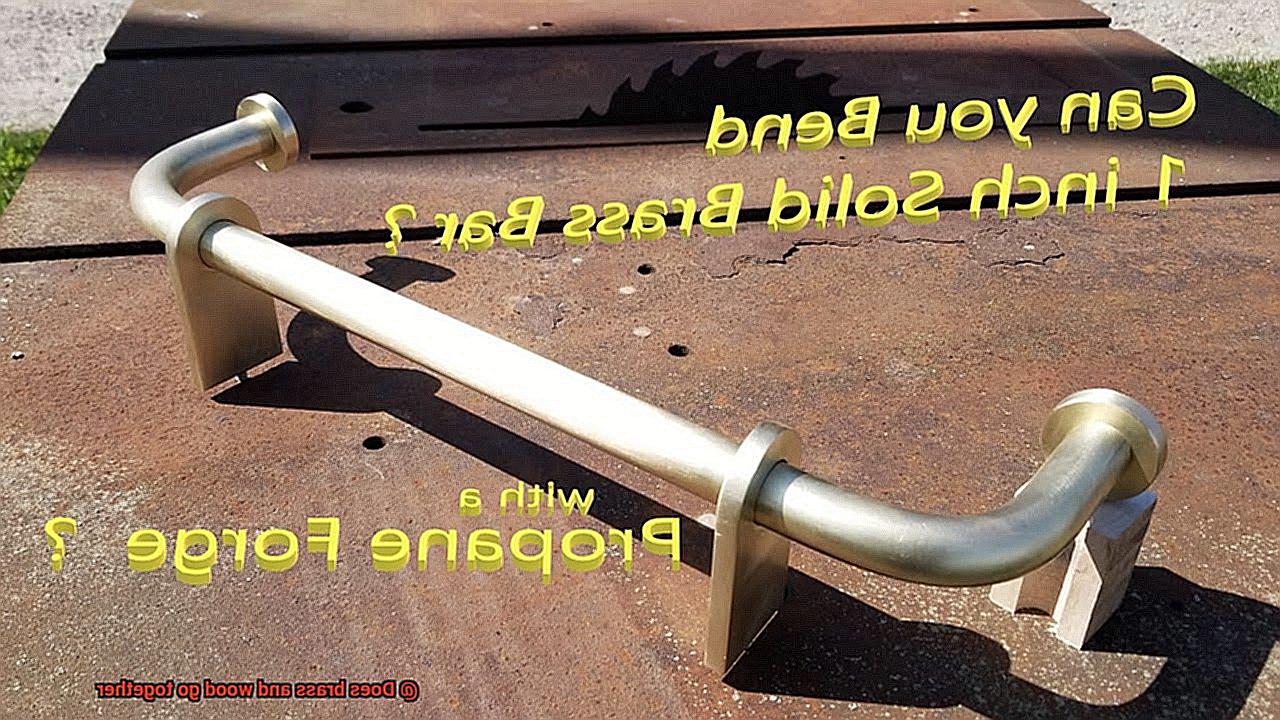
Musical Instruments:
The harmony between brass and wood finds its greatest expression in musical instruments. Trumpets, saxophones, and other brass instruments often feature wooden components that enhance their sound resonance. The seamless blend of bright metallic tones from brass with the warm, resonant notes produced by wood creates an auditory symphony that captivates listeners.
Furniture and Home Decor:
Brass accents have the power to transform ordinary wooden furniture into extraordinary pieces. Whether it’s drawer pulls, knobs, or decorative inlays, brass adds an element of elegance and visual interest to wooden furniture. The contrasting textures of smooth brass against the natural grains of wood create a visually stunning aesthetic that elevates any space.
Architectural Applications:
Architects and designers incorporate the timeless combination of brass and wood into fixtures and fittings. Brass door handles, hinges, or handrails paired with wooden doors or staircases create a look of sophistication and refinement. These durable fixtures can withstand heavy use while exuding a sense of luxury that enhances any architectural design.
Jewelry-making:
The union of brass findings or settings with wooden beads or pendants opens up endless creative possibilities in jewelry-making. This pairing allows for innovative designs that capture attention and create unique pieces that stand out from the crowd. The fusion of rustic wood with the metallic allure of brass creates jewelry that is both striking and conversation-worthy.
Kitchen Utensils and Tools:
Wooden handles on brass knives or cooking utensils provide a comfortable grip while infusing the kitchen with natural beauty. Both brass and wood possess antimicrobial properties, making them ideal for food-related applications where cleanliness is paramount. The combination of these materials ensures that functionality and aesthetics coexist harmoniously within the culinary domain.
Design Considerations for Combining Brass and Wood
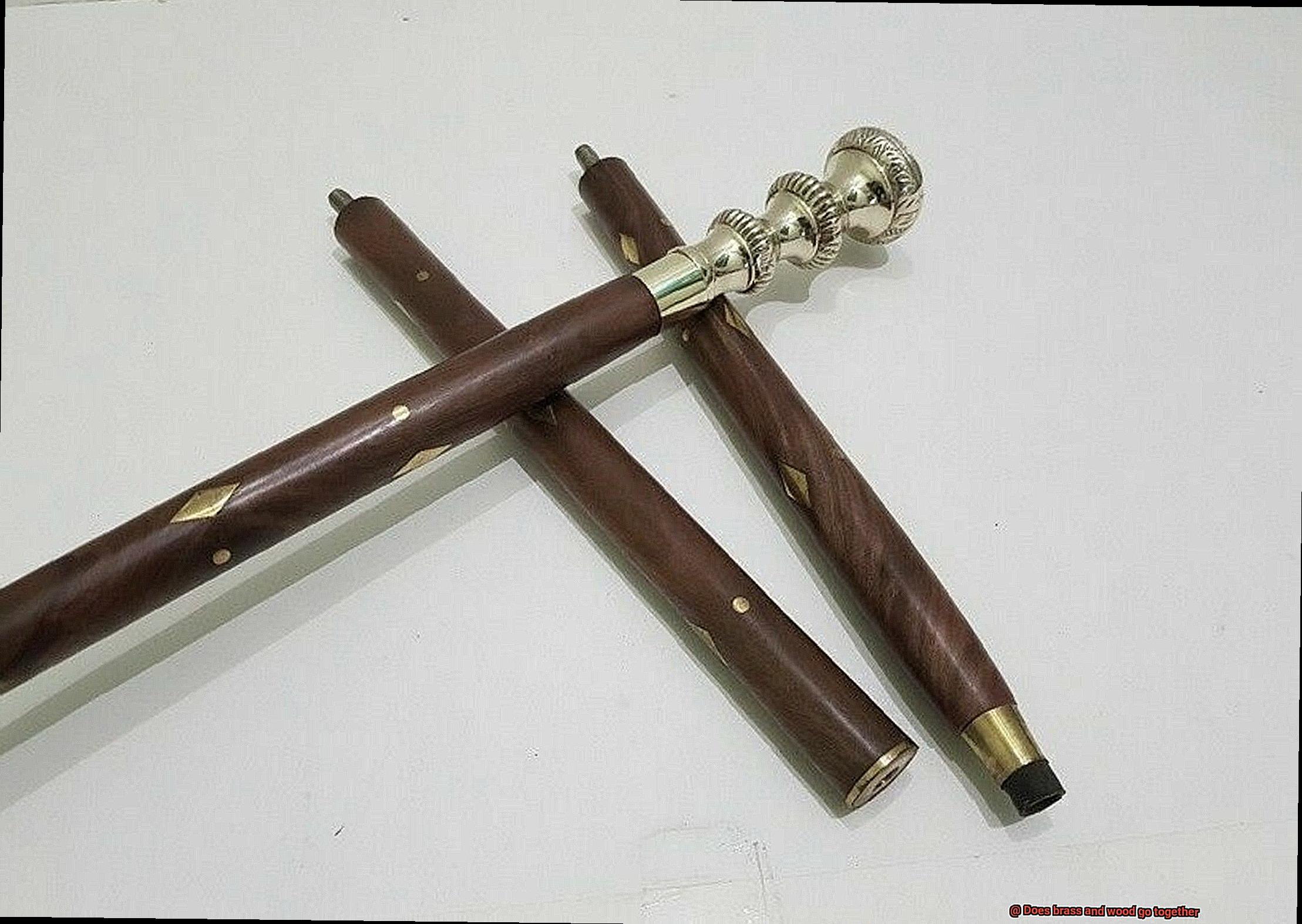
In the realm of design, few combinations are as timeless and captivating as brass and wood. The warm, natural tones of wood effortlessly harmonize with the lustrous, metallic shine of brass, creating a visual symphony that captivates our senses.
Whether it’s in musical instruments, furniture, jewelry, or architectural designs, the combination of these materials evokes a sense of sophistication and refinement. In this blog post, we will dive into the design considerations for combining brass and wood, exploring the types of glues that can be used, techniques for joining different materials, and other relevant information.
Aesthetics:
Bringing brass and wood together is a visual feast for the eyes. The contrasting colors and textures of these materials create a striking impact that commands attention. Dark woods like walnut or mahogany provide a rich backdrop for polished brass accents, exuding an air of luxury and elegance.
On the other hand, lighter woods like maple or birch offer a more modern and minimalistic look when paired with brushed brass, radiating a contemporary charm that is sleek and refined.
Compatibility:
Combining brass and wood requires careful consideration of their compatibility in terms of physical properties.

Wood is known to expand and contract with changes in humidity and temperature, while brass remains relatively stable.

To achieve a successful union, appropriate joinery techniques should be employed to allow for the natural movement of wood without compromising structural integrity. Techniques such as floating panels or sliding dovetails accommodate wood’s expansion and contraction while maintaining stability.
Durability:
Durability is paramount when combining brass and wood, especially if the final product will be subjected to regular use or environmental factors. Protective finishes on the wood can prevent scratches or staining, ensuring longevity and preserving its natural beauty. Similarly, clear lacquer or wax coatings on the brass maintain its luster over time, protecting it from tarnishing or corrosion. Choosing high-quality materials that have been properly seasoned and treated is also crucial for ensuring long-lasting durability.
Structural Integrity:
Maintaining structural integrity is essential when combining brass and wood. Properly sized components and suitable joinery methods ensure strength and stability, preventing any potential weak points in the design. Reinforcing elements such as screws or dowels can be discreetly incorporated to strengthen connections without compromising the overall aesthetic appeal of the piece.
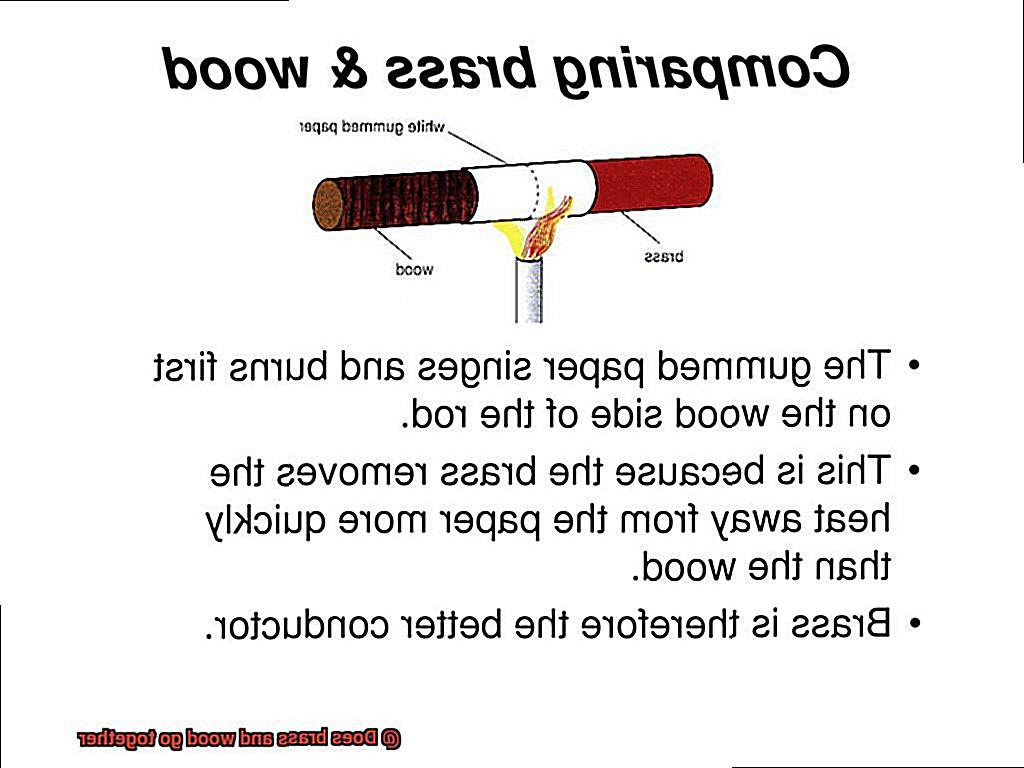
Functionality:
While the aesthetic appeal of brass and wood is undeniable, functionality should not be overlooked in the design process. Careful consideration should be given to weight distribution, ergonomic design, and ease of maintenance, particularly when incorporating this combination into furniture or architectural elements. Ensuring practicality and functionality guarantees that the combined piece will serve its purpose effectively, enhancing both its visual allure and usability.
Adhesive Options for Bonding Brass and Wood
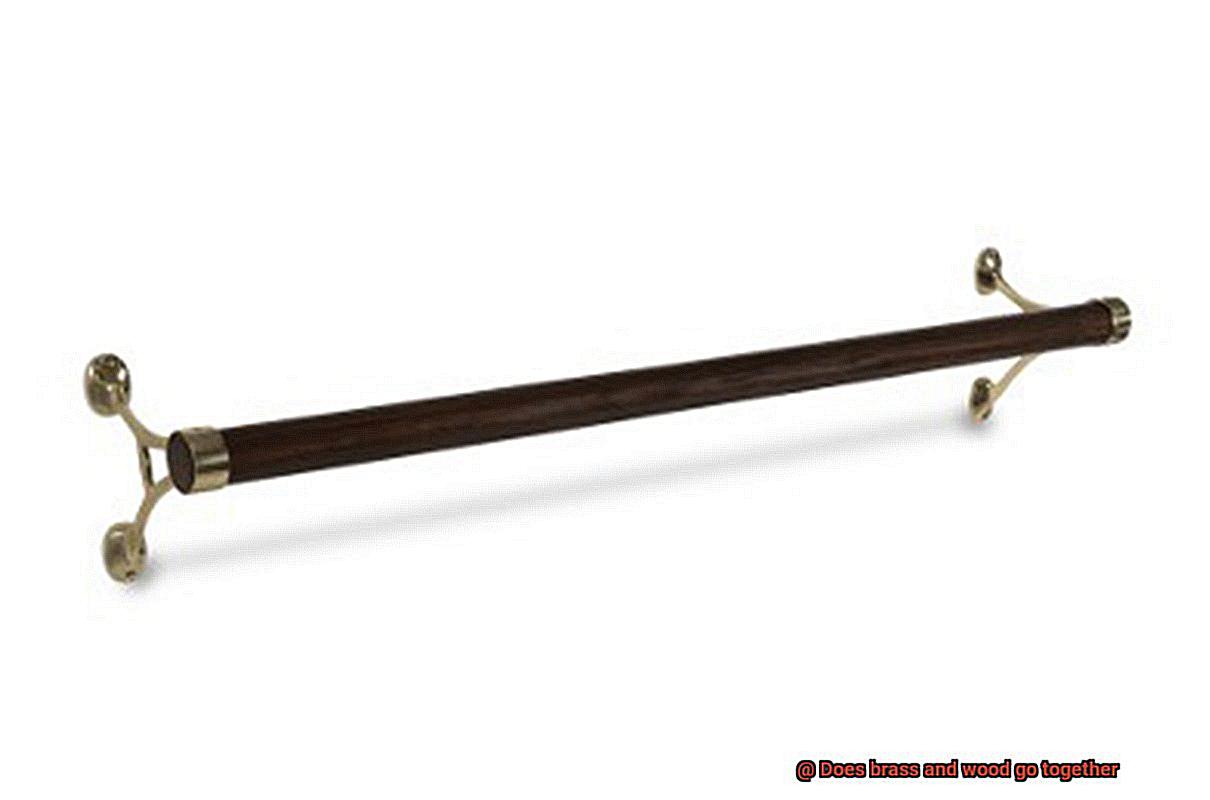
When it comes to bonding brass and wood, choosing the right adhesive is essential for creating a strong and durable bond. The right adhesive can seamlessly blend these two materials together, resulting in stunning pieces. Let’s dive into the world of adhesives and explore the options available.
Epoxy adhesive is a popular choice for bonding brass and wood. Known for its strong bonding properties and versatility, epoxy is suitable for a wide range of applications. It provides excellent shear strength and can withstand high temperatures, making it ideal for projects that require durability.
Polyurethane glue is another option to consider. This adhesive is known for its versatility and ability to bond different materials together, including brass and wood. What sets polyurethane glues apart is their ability to expand as they cure, filling gaps and creating a strong bond.
For a quick fix, cyanoacrylate adhesive, commonly known as super glue, might be the way to go. Super glue forms an instant bond between surfaces but may not provide as much flexibility as other adhesives. It is important to choose a cyanoacrylate adhesive specifically formulated for bonding metals like brass.
If you have more specialized applications, there are also adhesives designed specifically for bonding metal and wood. These often come in two-part systems, where an adhesive and activator or primer are used together to create a strong bond.
Before applying any adhesive, proper surface preparation is crucial. This involves thoroughly cleaning the brass and wood surfaces to remove any dirt, grease, or contaminants that could hinder adhesion. If necessary, roughening the surfaces can improve bond strength by creating a larger surface area for the adhesive to adhere to.
Mechanical Fasteners for Securing Brass and Wood
Mechanical fasteners provide a robust and reliable solution for securing brass and wood together, eliminating the need for messy adhesives. Let’s dive into the world of mechanical fasteners and explore the best options for joining these materials.
- Screws: These versatile wonders are easy to use and offer a strong and secure connection. Brass screws, specially designed for brass components, ensure a perfect match. To prevent splitting and ensure a snug fit, remember to pre-drill pilot holes in the wood.
- Nails: While not as strong or secure as screws, nails can still be a viable option for certain applications where strength is not the primary concern. They are quick and easy to use, making them popular for smaller projects.
- Dowels: For larger and heavier applications like furniture construction or cabinetry, dowels are the way to go. These cylindrical rods are inserted into pre-drilled holes in both the brass and wood components, creating an incredibly strong joint. Dowels provide excellent alignment and stability, making them a go-to choice for woodworking enthusiasts.
- Bolts, Nuts, and Washers: When even more strength and security are required, bolts, nuts, and washers can be used. These specialized fasteners are perfect for heavy-duty applications.
When selecting mechanical fasteners, consider the weight of the objects being joined, the intended use of the final product, and your aesthetic preferences. Choose high-quality fasteners suitable for the materials being joined to ensure a durable connection.
Maintenance Tips for Preserving the Beauty of Brass and Wood
The combination of brass and wood creates a visually stunning and harmonious aesthetic. To ensure that these materials retain their natural beauty, regular maintenance is essential. This article provides valuable tips on cleaning, polishing, protecting, and handling brass and wood to preserve their timeless elegance.
Regular Cleaning:
To maintain the beauty of brass and wood, regular cleaning is crucial. Gently remove surface dust using a soft cloth or feather duster. Avoid abrasive materials or harsh chemicals that can cause damage. For brass, create a natural cleaning solution by mixing equal parts vinegar and water. Use a cloth soaked in the solution to gently rub the brass surface in a circular motion. Rinse with clean water and dry thoroughly to prevent any damage to the wood.
Polishing Brilliance:
To restore the shine of brass, consider using commercial brass cleaners or polishes. Test it on a small area before applying it to the entire surface. Polish the brass using a soft cloth until it shines brilliantly. Wood surfaces should be regularly dusted using a soft cloth or feather duster. For deeper cleaning, use a mild soap and water solution. Gently wipe the surface with a damp cloth and immediately dry it to avoid water damage.
Protective Measures:
To safeguard your brass and wood from scratches and stains, use coasters or placemats under glasses or hot dishes. Avoid placing sharp objects directly on wood surfaces to prevent permanent marks. Additionally, both brass and wood are sensitive to excessive sunlight and humidity. Place them away from direct sunlight, use curtains or blinds to filter light, and control humidity levels with dehumidifiers or air conditioners.
Gentle Handling:
Handle brass and wood items with care to prevent scratches or dents that are difficult to repair. Avoid dragging them across surfaces or using excessive force when cleaning or moving them. Lift and carry these items carefully to ensure their longevity.
Regular Inspections:
Regularly inspect brass for signs of tarnish, scratches, or dents that may require professional repair or restoration. Similarly, examine wood for cracks, splits, or areas where the finish may be wearing off, which may need attention from a professional woodworker or furniture restorer.
Cleaning Techniques for Keeping Brass and Wood Looking Great
Brass and wood, a timeless combination that adds elegance to any space. From vintage furniture to musical instruments, these materials require proper care and maintenance to maintain their beauty and longevity. In this article, we will explore the best techniques for keeping brass and wood looking great.
Cleaning Brass:
- Vinegar and Water Solution: Create a gentle cleaning solution by mixing equal parts vinegar and water. Apply it to the brass using a soft cloth or sponge, gently rubbing in circular motions to remove tarnish or dirt. Rinse with clean water and dry thoroughly.
- Baking Soda and Lemon Juice Paste: Make a paste with baking soda and lemon juice for stubborn stains or tarnish. Apply the paste to the affected areas, let it sit for a few minutes, then gently scrub with a soft brush or cloth. Rinse with water and dry thoroughly.

Maintaining Wood:
- Regular Dusting: Use a soft cloth or feather duster to regularly dust wood surfaces, preventing the buildup of dirt and debris. Avoid abrasive materials that can scratch the finish.
- Immediate Stain Removal: Clean spills or stains on wood immediately to prevent them from setting in. Mix mild dish soap with warm water to create a mild soap solution. Dip a soft cloth into the solution, wipe the stained area following the grain of the wood, and avoid excessive moisture.
- Wood Polish or Wax: Restore shine to wood surfaces by applying a high-quality wood polish or wax according to the manufacturer’s instructions. Buff gently with a soft cloth for a lustrous finish.
Regular maintenance is key to keeping brass and wood looking great. Incorporate these cleaning techniques into your routine to preserve their beauty for years to come. By doing so, you’ll be able to enjoy the timeless elegance of brass and wood in your home or studio.
Conclusion
In conclusion, the union of brass and wood is an enchanting coupling that effortlessly melds classic charm with contemporary allure. The visual allure of this combination lies in the distinctive qualities of each material and the harmonious equilibrium they create.
Brass, with its resplendent and radiant tones, exudes an air of elegance and sophistication. Wood, on the other hand, brings forth warmth and natural beauty with its earthy hues and intricate grain patterns. When these materials intertwine, their contrasting characteristics forge a visually striking juxtaposition that is truly captivating.
The versatility of brass and wood allows them to seamlessly integrate into various design themes, ranging from modern to traditional. By meticulously selecting the color palette, texture, and overall design scheme, one can evoke different moods and atmospheres. The pairing of lighter shades of wood with polished brass can generate an ethereal and refined ambiance ideal for contemporary spaces. Conversely, darker woods complemented by antique brass finishes can evoke a vintage aesthetic brimming with opulence.
Beyond their aesthetic compatibility, brass and wood also boast functional applications across numerous industries. From musical instruments to furniture design, architectural marvels to exquisite jewelry creations – the marriage of these materials offers boundless possibilities for crafting both beautiful and practical pieces.
When incorporating brass and wood into your own projects, it is imperative to consider key design considerations such as aesthetics, compatibility, durability, structural integrity, and functionality. Selecting the appropriate adhesive or mechanical fasteners is paramount in ensuring a robust bond between these materials.
To preserve the timeless beauty of brass and wood over time, regular maintenance becomes indispensable. Employing cleaning techniques involving vinegar or baking soda for brass alongside regular dusting for wood will help sustain their splendor for years to come.
In essence, brass and wood form an unbeatable alliance that infuses any space with gracefulness and refinement. Whether integrated into furniture designs or architectural elements or utilized in decorative or functional applications like lighting fixtures or musical instruments – this captivating pairing will eternally embody an enduring allure.

